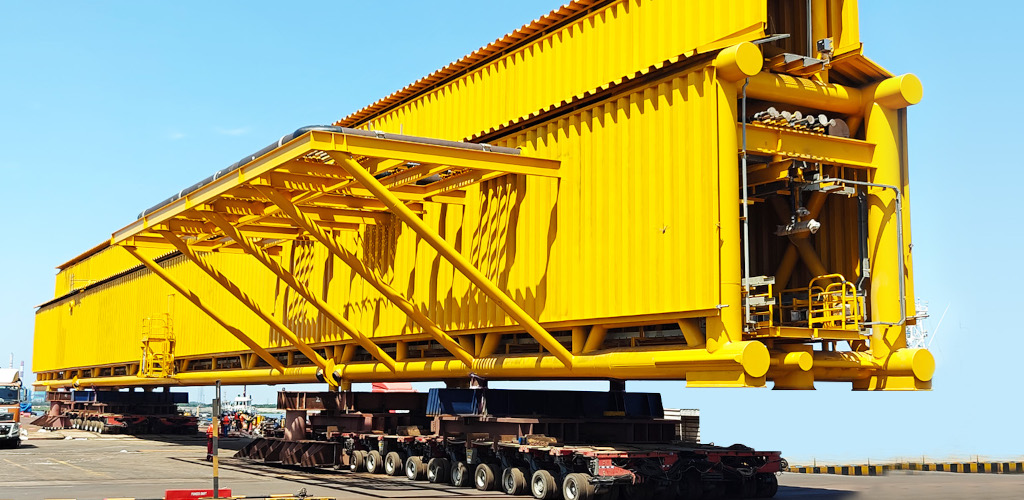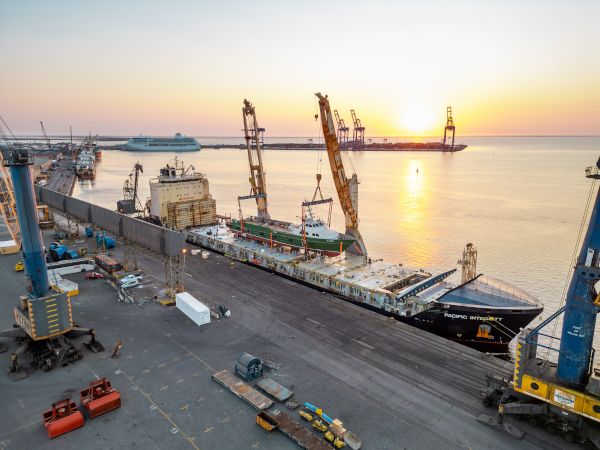Nov 14 | 2024
Power-Hungry Region To See Raft of New Projects

By Luke King
Following an overview by the Energy Industries Council (EIC) of key energy projects and trends across Asia, project professionals offer their perspectives on some of the crucial challenges facing the region’s breakbulk sector.
From Breakbulk Magazine’s Issue 6, 2024 Global Outlook series.
EIC Analysis:
Asia is projected to experience significant growth in energy demand and emissions, driven largely by China, India and Southeast Asia. By 2025, the region will consume half of the world’s electricity, with coal remaining the dominant energy source despite an increase in renewables.
There are distinct variations in energy priorities: South Korea and Japan, resource-poor nations, are heavily dependent on imports, while resource-rich Australia leads in LNG, coal and mineral exports (Figure 1). In contrast, China and India, with high energy needs and coal dependency, face unique decarbonization challenges. For emerging economies like Thailand and Vietnam, infrastructure shortages and project funding issues remain obstacles.
Most regional investments are directed toward oil and gas, which continue to receive the majority of capital expenditures achieving FID (Figure 2). However, challenges like declining oil production in India and Indonesia, Australian offshore project delays, and reduced LNG competitiveness persist.
Governments are responding by bolstering support: Indonesia plans to offer 54 new exploration blocks by 2028, India is enacting policy reforms, and Australia’s Future Gas Strategy emphasizes natural gas as a transitional energy source.
Decarbonization efforts are growing but face hurdles, including regulatory gaps and financing issues. Markets like Australia, Malaysia and Indonesia show potential for CCS, especially in hard-to-abate sectors. Hydrogen projects in Australia, South Korea and India are gaining traction, though FID rates lag behind the EU and the U.S.
The Asia-Pacific region is also advancing in offshore wind, with a 331GW project pipeline (Figure 4). Taiwan and South Korea are leaders in proposed capacity and planned auctions, though Taiwan’s local content requirements and supply chain limitations are increasing costs and causing delays. Despite these challenges, strategic investments are positioning Asia-Pacific as a critical player in the global energy transition.
Q&A With Local Leaders
1. What is your business outlook for 2025?
 Dharmendra Gangrade, head of Larsen & Toubro Logistics Management Center:
Dharmendra Gangrade, head of Larsen & Toubro Logistics Management Center:The overall business outlook for 2025 looks very positive with many research organizations projecting continued investment in capex, especially in India. The “Make in India, Make for the World” campaign has already generated substantial interest among multinational companies, many of whom have made significant investment in India in the last five years.
Koichi Kaizu, subject matter expert – logistics / module transportation, JGC Corporation:
Our business outlook for 2025 is optimistic. We aim to enhance our competitiveness and profitability in large-scale EPC projects, including LNG receiving terminals, solar power, biomass power, pharmaceuticals, hospitals and the chemical sectors.
 Namir Khanbabi, general manager, Swire Projects:
Namir Khanbabi, general manager, Swire Projects:The outlook for 2025 is cautiously optimistic. Forecasted demand for breakbulk and project cargo remains strong, driven by ongoing and expected infrastructure projects and the energy sector. That said, we are in a very volatile geopolitical environment, which has the potential to change circumstances unexpectedly, without a clear view of whether this will provide opportunities or create issues.
Sameer Parikh, president/ chief business officer, J M Baxi Heavy:
We’re expecting a series of new projects to occur across India and the surrounding region, especially starting in Q2-Q3 of 2025. We expect logistics activities to really pick up over the next few years.
_2.jpg?width=150&height=150) Ge Yanhua (“Stella”), director, Chipolbrok:
Ge Yanhua (“Stella”), director, Chipolbrok:We are confident for next year. In particular, we see a strong export market from the Far East, versus weak exports from Europe, which is struggling with poor growth, high costs and a lack of competitiveness. The Chinese export industry is booming - whether car production, wind power equipment or numerous industrial components – but the question is to what extent growing protectionism will influence volumes?
2. What sectors or specific new projects in your region do you think will be significant for breakbulk and project cargo in the coming year?
Gangrade:
The energy sector, including renewable energy-related project cargo, will be the driver for growth in Asia. More and more new projects are being announced in the region, often with very tight project schedules and higher instances of modularization, which will increase demand on specialized carriers and equipment.
Kaizu:
Significant sectors for breakbulk and project cargo in the coming year will be energy transition projects (LNG, CCS), renewable energy projects (offshore wind farms, biomass power plants, hydrogen and ammonia) and infrastructure projects including chemical recycling.
Khanbabi:
In our region, significant projects are in the renewable energy, mining, and oil and gas industries, as well as some large-scale infrastructure projects, which drive demand for breakbulk and project cargo services.
Parikh:
We’re anticipating growth primarily in offshore oil field projects, as well as in the oil and gas and power sectors. The nuclear sector is on the rise in India, though it seems the timelines are a bit longer, with visible outcomes expected around 2028.
Janusz Kuzmicki, director, Chipolbrok:
There remains increasing demand for alternative green energy projects, in which China has a remarkable impact as producer and supplier of such equipment. This is our main market for our westbound trades, together with other big projects sourced from the Asia region.
3. Do you think the existing infrastructure (ports, terminals, vessels) in Asia is prepared to handle the demand for breakbulk and project cargo? What improvements or resources are needed, if any?
Gangrade:
Existing infrastructure for handling project cargo in some ports may not be adequate and requires modernization in order to meet the complexity of ever-larger cargo. In particular, ports in India needs to focus on upgrades to keep pace with growing demand and be more efficient.
Kaizu:
Our view is that Asia’s infrastructure is generally robust for breakbulk and project cargo. In the meantime, for the purpose of very large modules, enhancements in port capacity, modernization of terminals and investment in specialized vessels are necessary to ensure efficient handling and transportation.
Khanbabi:
While Asia’s port infrastructure has seen significant improvements, there are still issues around inland logistics to meet the demand. Ports and terminals are enhancing their port capacity and crane lift capability, which may decrease demand for more specialized vessels able to handle oversized and heavy cargo, so this poses a threat as well as an opportunity.
Parikh:
While many ports in India handle containerized cargo, project and heavy cargo often depend on a few key facilities, leading to delays and increased costs. With the expected growth in larger cargo, India needs more ro-ro ports with strong deck capacity and specialized facilities. Current infrastructure is underprepared for rising demand, requiring significant improvements in port equipment, terminal capacity and clearance processes. Addressing these challenges will enhance logistical efficiency and support the country’s booming infrastructure projects effectively.
Yanhua:
We have clearly observed that certain regions are investing a lot into new infrastructure, especially in China, the Far East and Southeast Asia, where we feel well supported. But we must also admit that some ports fail to invest, have low productivity and are cost-intensive, with a lack of focus on breakbulk cargo. If we add to these problems with getting skilled labor, we see it as one of the obstacles to handling project cargoes.
4. What trends are you seeing in freight rates, and do you anticipate these changing? What factors influenced your answer?
 Gangrade:
Gangrade:In my view, freight rates will remain volatile (moving upward for now) in the short- to mid-term due to various factors such as geopolitical developments, capacity constraints, regulatory restrictions by major economies and demand seasonality. Let’s accept the hard fact that the global supply chain will remain disrupted for a considerable period and the world will have to get used to this volatility.
Kaizu:
Freight rates have been volatile. While fuel price fluctuations are no longer a major critical factor, the freight rate is being influenced heavily by other factors such as geopolitical tensions, supply chain disruptions, climate change, decarbonization and compliance requirements. Therefore, we anticipate that freight rates will remain high in the near term, due to ongoing global uncertainties.
Khanbabi:
There is a robust demand for project cargo, which may push up rates throughout 2024 and into 2025. This demand is largely driven by infrastructure projects and renewable energy developments. The global economic outlook for 2025 is generally positive, which will support the growth of the shipping industry. However, geopolitical tensions could pose additional challenges.
Parikh:
The freight market has been pretty unpredictable since covid. We’ve experienced challenges like container shortages and geopolitical tensions in areas like the Red Sea, as well as the situation in Ukraine and current issues between Iran and Israel. With fewer players in the heavy cargo sector and growing coastal movement needs in India, we anticipate vessel shortages and rising rates, which complicates planning and budgeting.
Kuzmicki:
The political situation in the Middle East, armed conflicts and transit risks in the Red Sea and Arabian Gulf will continue to impact the shipping industry negatively. Consequently, this impacts prices for consumers. We also keep in mind increased costs relating to emissions, which will rise as of January 1, 2025, so we need to make more allowances in trades to/from the European Union.
5. What are the biggest challenges for your sector in the year ahead, and how is your company preparing to navigate them?
Gangrade:
Volatile freight rates, non-availability of space and the scarcity of resources in terms of equipment and staff are the major challenges we see in the near future. We are addressing these challenges through better and advance planning by using a digital platform which helps us consolidate requirements across the business. There are growing concerns around the availability of skilled personnel on the shipper side too, since logistics is not the first choice of career for many youngsters.
Kaizu:
For us, the biggest challenges will be managing supply chain disruptions, meeting sustainability goals and regulatory changes. JGC is investing in digital transformation, enhancing risk management practices and collaborating with stakeholders to develop sustainable solutions for future growth.
Khanbabi:
Our biggest challenges going forward come from geopolitical tensions, tonnage capacity constraints and the costs of meeting increasing environmental regulatory requirements. In terms of how we are going to navigate them, we adopt a risk-based trading approach to minimize exposure to geopolitical risks. We are actively looking at the tonnage market for opportunities within the charter market for additional capacity in the short- to medium-term.
Whilst we are looking at the newbuilding market, with the present ship prices we feel that levels need to come off to make the investment attractive. In terms of the environmental regulations, our sustainability team are actively pursuing strategies to reduce our carbon footprint, look at new fuels, technologies and strategies to meet our longer-term reduction targets. Additionally, we are engaged in ongoing discussions with our customers regarding the financial implications of these regulations, as opinions differ on who should bear the costs.
Parikh:
A major challenge we foresee is the need for larger assets that meet specific project requirements, along with keeping up with customer expectations. To stay competitive, we know we need to be proactive. However, finding the right balance between investments and expected returns can be tricky, so we’re focusing on careful planning and management to address these challenges.
Yanhua:
Our ship captains are confronted with overwhelming bureaucracy, especially in Europe. On top of increasing regulations to protect the oceans and the climate, which of course are necessary, new ships must follow requirements around designs, propulsion systems and more environmentally-friendly operating fuels. We are prepared to integrate these features into our future ships, however there is still a big question mark around which fuel and which propulsion system will be used, since there are still many issues to be settled in respect of availability and cost of such fuels. So, we treat this as a process that will take time.
6. Is the balance between global and regional supply chains changing, and, if so, in what ways?
Gangrade:
Yes, supply chains don’t always cross multiple oceans anymore. Strong regional supply chains have been developed, designed to be less susceptible to global events. After the covid pandemic, many large companies altered their global supply chains, with nearshoring an increasing feature.
Kaizu:
Considering geopolitical risks and the need for greater supply chain resilience, it would be ideal if we can shift to more regional supply chains. However, we don’t have a clear view or detailed execution plan at this stage for adopting nearshore or friendshoring strategies in order to reduce dependency on distant suppliers. This is because our projects require a certain level of engineering quality assurance, based on proven technology.
Khanbabi:
Global and regional supply chains are changing in the current economic and geopolitical climate where regionalization, nearshoring and local sourcing are all increasing. We see this in the wind sector in the Atlantic basin, particularly for the North American market. The movement away from a reliance on China is still prevalent in some markets which have shifted to sourcing from Southeast Asia, India or the Middle East.
Kuzmicki:
China is a good example to consider. Inland demand has been boosted whilst simultaneously the country is on its way to becoming a leading global producer of environmentally-friendly electric cars. The same can be said about other industrial sectors. We recognize that there is a shift towards focusing on domestic markets in Asia, this applies particularly to India.
Read more in the series:
Global Outlook: Middle East & Africa
Global Outlook: Europe
Global Outlook: Americas
TOP PHOTO: J M Baxi moves project cargo. Credit: J M Baxi
SECOND: Swire Shipping loads a yacht onto the Pacific Integrity. Swire
